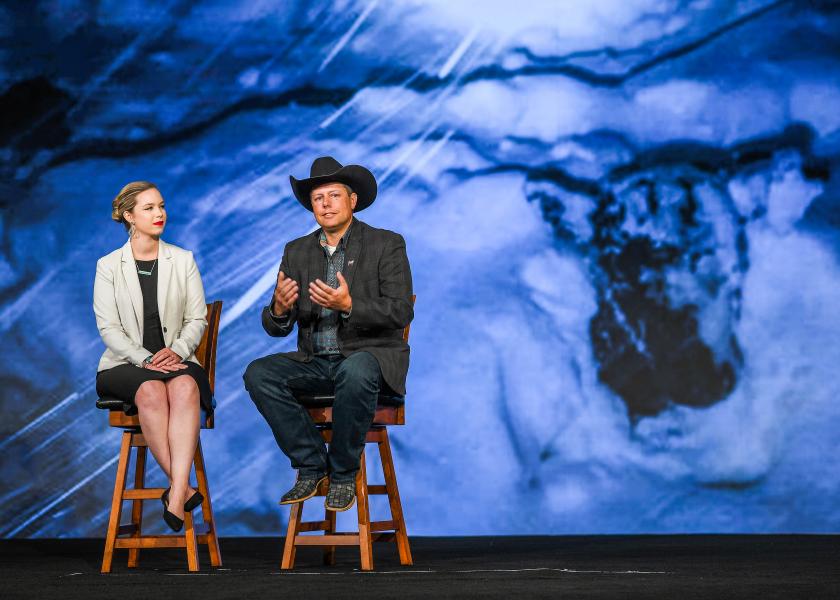Sharing Stories, Tools, Facts To Spur Beef Sales

Showing a little of the humanity in ranch life—what may sound simple was a significant role for cattlemen at the 2019 Certified Angus Beef ® (CAB®) brand’s annual conference in Asheville, N.C., in September.
More than 700 people from packer and processor to restaurateur and retailer gathered for the event that is part celebration, part education, part pep rally, but all about the relationships.
In between motivational speakers like former Blue Angels pilot John Foley and new sales-marketing inspirations, Kansas Angus breeders Chris and Sharee Sankey and Neal and Marya Haverkamp shared their stories in a live interview.
They covered the wonder and challenges of raising cattle and kids in tandem, explained showing cattle as the “NASCAR of the beef business” and shared lessons learned in agriculture.
Marya Haverkamp talked of working alongside her husband, reaching goals together.
“It’s overwhelming,” she said, before adding some levity. “Now don't get me wrong—on the days we work cattle, I have to remind myself I love him, even though I don't really like him right now. But my heart is full when I see him helping the kids and it's full circle.”
The session brought to life pages from the new coffee-table book, “Sheltering Generations: The American Barn,” set for a December release. Every penny from book sales will support a new Rural Relief Fund that CAB will use to contribute to organized efforts during times of natural disasters.
South Dakota cattleman Troy Hadrick shared a slice of what it’s like to literally weather a storm, describing this April’s devastating blizzard on his Faulkton, S.D., ranch.
“You’ve got this unwritten, unspoken contract with your cows that you'll take care of them and they in turn take care of you. We didn’t save them all, but we did the best we could,” Hadrick said.
During the storm, his wife Stacy and their three kids were all working together in the elements to save calves. It was just a quick stop back at the house for food, when Hadrick looked over and saw his daughter, head in her hands, sobbing.
“We had just pushed her a little too hard. She was kind of emotionally and physically exhausted,” he said. “That was tough for a dad to see.”
The audience felt that emotion.
But it wasn’t just about showing who ranchers are, it was about explaining what they do.
During a sustainability session, panelists put a face on how the production sector is improving animal care and environments. James Henderson, Bradley 3 Ranch; Tom Jones, Hy-Plains Feed Yard; Chris Ulrich, Ulrich Farms; and Sara Place, National Cattlemen’s Beef Association, each shared examples ranging from experience in the Chesapeake Bay watershed to feeding cattle in western Kansas.
Henderson said they hit a turning point when a range specialist visited their Childress, Texas, ranch in 1995.
“At the end of the day, he made a comment that cut to the bone,” Henderson recalled. “He said, ‘This is the most under-stocked, overgrazed ranch I've ever been on.’ That's not what you want to hear as a rancher.”
They made a 20-year plan, where they developed water, implemented aggressive brush control and planted native forage. Increased carrying capacity shows it’s working.
Ulrich had his own stories of fencing out creek beds and introducing contour strips on his Pennsylvania farm ground. Jones described collaborative work at his feedyard’s education and research center, and building up the next generation through internships.
Place put the media hype in perspective, noting it takes fewer cows to produce more beef today than it did decades ago.
“Those are huge reductions in the amount of greenhouse gas emissions, the amount of natural resources, everything else it takes to make it a really high-quality product,” she said.
The panel ran out of time before they’d answered all the audience questions, but the entire conference encouraged one-on-one interaction among people from different parts of the beef business.
CAB recognized leaders in packing, retail, foodservice, value-added processing and production with annual awards. They announced new programs, such as Steakholder Rewards—a new consumer brand loyalty program—and the Meat Speak podcast. The sales team equipped people selling beef with more tools and tactics for success.
“I really believe this brand was the lead that changed what was going on in our market,” said Randy Blach, CattleFax CEO, during his market update. “Somebody had to say we are not going to be an ingredient. We have a story to tell.”
Since 1998, consumer spending on beef has increased by $62 billion, more than the increase in outlays on pork and poultry combined, he said.
“There are some out there who will make you think people have quit eating beef. We have record consumption in the U.S.,” Blach said.
CAB sales hit a record 1.25 billion pounds, said John Stika, CAB president, noting 3.1% growth for the fiscal year ending in September.
“What I continue to find absolutely energizing about this event every year is that when you bring this many people together in one place focused on one brand, there arises a creativity, a momentum that fosters great ideas and only serves to further fuel an even-stronger pursuit of excellence moving forward,” he said.







